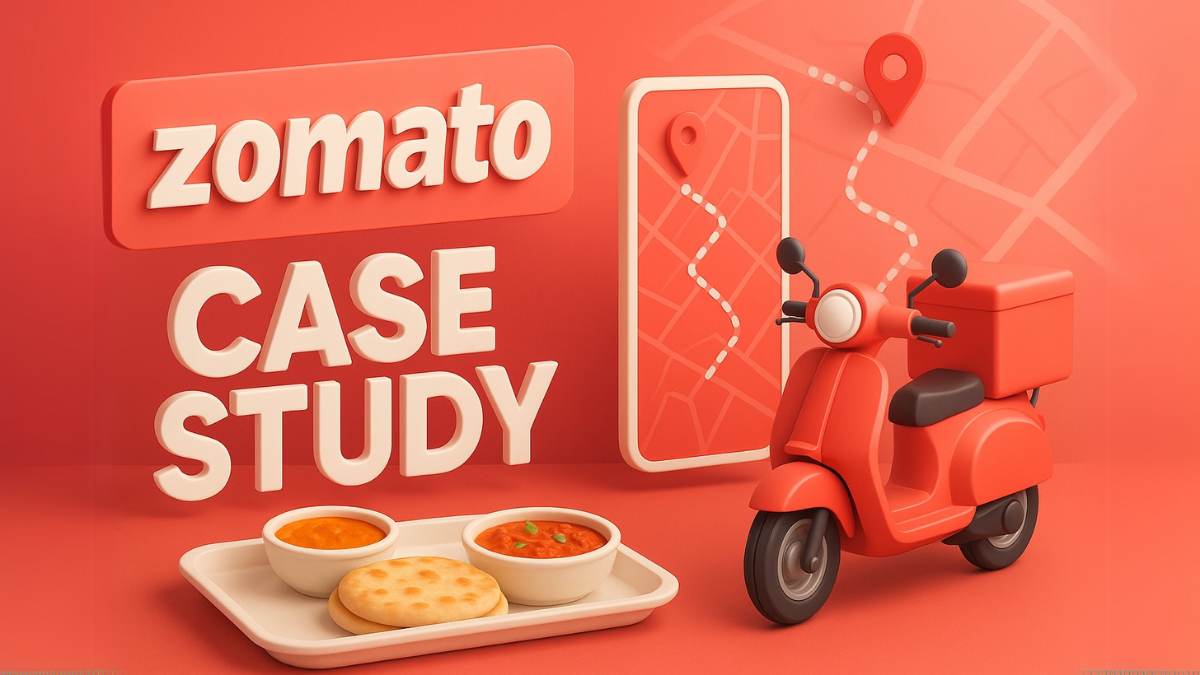If you’ve ever been too lazy to cook or just craved something good, chances are you’ve opened Zomato. It’s that go-to app most of us use when we’re hungry and want food fast. Over the years, it’s gone from a simple restaurant finder to one of the biggest food delivery platforms in India.
Table of Contents
But Zomato is more than just an app that gets your order to you. It’s built a voice, a vibe, and a strong connection with people. Funny push notifications, bold ads, memes, and smart tech, it’s all there.
This Zomato case study isn’t just about food delivery. It’s about how Zomato used smart marketing, sharp design, and real understanding of Indian users to grow fast and stand out. Let’s break it down.
Zomato Company Overview
Who Started Zomato?
Zomato was started back in 2008 by two IIT Delhi grads, Deepinder Goyal and Pankaj Chaddah. It wasn’t a big, flashy launch. Actually, the idea came from something really small.
In their office, colleagues would always ask them for restaurant menus. Deepinder got tired of it, scanned a few menus, and uploaded them online. That was it. That was the beginning.
It was first called Foodiebay. Not the best name, right? Later, they rebranded to Zomato in 2010, which honestly just sounds cooler and more global.
What Does Zomato Believe In?
Zomato’s mission is pretty simple: better food for more people.
But it’s not just about the food. The team has always been very experimental, bold, and kind of quirky. You can feel it in their social media posts, their app copy, even their email subject lines.
They’ve built a culture that doesn’t sound like a stiff corporate voice. They sound like that funny, slightly sarcastic friend who sends you memes at midnight. That’s part of what makes them special.
Zomato’s Growth Story: From Startup to Super App
Zomato didn’t become a household name overnight. It took years, a bunch of smart decisions, and some solid risks. Let’s walk through how it all played out.
Quick Timeline
- 2008 – Foodiebay is launched. Just menus. No delivery yet.
- 2010 – Name changes to Zomato
- 2011–2013 – They start expanding to other countries like the UAE, UK, and South Africa
- 2015 – They add food delivery (huge step)
- 2018 – Zomato Gold is introduced
- 2020 – They buy Uber Eats India
- 2021 – Zomato goes public (yep, stock market)
- 2023–2025 – Add groceries, intercity delivery, more experiments
How Did It Start Getting Popular?
In the beginning, it was all about helping people find good restaurants. They nailed that.
Back then, most of us didn’t have easy access to menus or reviews. Zomato solved that, and people loved it. So they told their friends, who told their friends, and boom, it started spreading.
When food delivery came in around 2015, things really blew up. Suddenly, Zomato wasn’t just for planning dinner, it was for ordering it. That changed everything.
And then, when COVID hit, delivery became essential. Zomato adapted fast, and that helped them grow even more.
The Different Stages of Growth
- Menu Discovery (2008–2012): Just showing menus and restaurant info
- Global Expansion (2013–2015): Moved into other countries
- Delivery Phase (2015–2020): Food delivery becomes core
- Full Ecosystem (2020–now): Grocery, B2B supply, events, subscriptions
They’ve tried a lot over the years. Some things worked, some didn’t, but they never stopped moving.
How Zomato Makes Money (Business Model Breakdown)
Let’s be real: Zomato isn’t just delivering food for fun. It’s a business. So how do they make money?
Turns out, there are a bunch of ways.
1. Delivery Commissions
Every time you place an order, the restaurant gives a small cut to Zomato. That’s the main chunk of revenue.
2. Zomato Gold / Zomato Pro
Zomato launched its Gold membership in 2017, offering benefits like 1+1 on food and drinks at partner restaurants. In 2020, Zomato Gold was replaced by Zomato Pro, and later reintroduced as Zomato Gold in 2023 with new benefits such as free delivery on select orders and dining discounts
3. Ads for Restaurants
Restaurants can pay Zomato to show up at the top of search results inside the app. Think of it like Google Ads, but for biryani.
4. Hyperpure (B2B Model)
Zomato operates Hyperpure, a B2B platform launched in 2018, which supplies fresh ingredients and kitchen essentials to restaurants. Hyperpure operates in 10 cities and serves over 30,000 restaurants, with revenue doubling year-over-year as of 2024.
5. Dining Out & Events
Zomato also helps users book tables, access dining deals, and even attend food events or fests. It’s a small part of the business, but it adds to the overall brand.
Also Read: Netflix Case Study
Who Uses Zomato? (Target Audience)
Zomato has always been very clear about who they’re building for.
Typical Zomato Users:
- Urban professionals
- College students
- Working couples
- People living away from family
- Basically, anyone who doesn’t want to cook
Most of their users are between 18 to 35 years old. They’re tech-savvy, they live in cities, and they order food often, especially late at night, on weekends, or during office hours.
Also Read: AirBnb Customer Acquistion Case Study
What Zomato Knows About Their Users
They don’t just guess who their audience is. They study them closely.
- They know what time people usually order (hint: lunch and dinner, but also late-night snacks)
- They know which cuisines trend on weekends (Chinese, Mughlai, pizza)
- They even track which locations need more delivery partners
All this helps them send better push notifications, suggest smarter options, and improve delivery timing.
Also Read: Starbucks Case Study
The Competition: Zomato vs Swiggy (and Others)
Let’s talk about the elephant in the room, Swiggy.
Zomato and Swiggy have been going head-to-head for years now. They both do food delivery. They both have sleek apps. They both offer quick grocery services, too.
But they feel different, don’t they?
What Sets Them Apart?
| Feature | Zomato | Swiggy |
| App Personality | Witty, quirky, meme-driven | Straightforward, clean, utility-first |
| Social Media | Funny, casual, highly viral | Professional, less humorous |
| Other Services | Dining, Intercity, Zomato Gold | Instamart, Genie, Swiggy One |
| Content & Branding | Loud, colorful, full of personality | Calm, efficient, more reserved |
Zomato wins when it comes to brand recall and creativity. Swiggy focuses more on speed and service.
They both have loyal fans, and honestly, most people have both apps installed. It’s just about who gives the better deal at that moment.
Also Read: Amul Case Study
Zomato’s Digital Marketing Strategy (Deep Dive)
If there’s one thing Zomato does really, really well, it’s digital marketing. They don’t just run ads. They talk to their audience in a way that feels real. Fun. Even emotional sometimes.
Let’s break down how they do it:
1. SEO (Search Engine Optimization)
Zomato shows up at the top when you search for something like “best momos in Delhi” or “budget restaurants in Bandra.” That’s not an accident.
They’ve put in a lot of work into:
- Writing local food blogs
- Creating city-specific food lists
- Tagging restaurants with detailed keywords
They also have a Zomato blog, where they talk about food trends, lifestyle content, and sometimes even dating advice (yes, really). This content brings a lot of organic traffic from Google.
2. Social Media: Memes, Relatability & Voice
This is where Zomato really shines.
They don’t post boring ads. They post:
- Food-related memes
- Funny one-liners
- Quirky tweets (sometimes with spelling mistakes on purpose)
- Replies to trending topics, movie releases, IPL matches, you name it
They talk like their users. They sound like a friend who’s hungry and dramatic at the same time. That’s what makes people want to follow them.
3. Push Notifications
We’ve all received those funny Zomato push messages, right?
They’re not just reminders. They’re full of personality. Examples:
- “Your crush might ignore you, but we won’t.”
- “Paneer is temporary. Biryani is forever.”
And it’s not random. They use your order history and location to time these messages perfectly.
4. Email & WhatsApp Marketing
Zomato also sends emails that don’t feel like emails. Their subject lines are clever and their content is usually short and playful. Same with WhatsApp updates, they send order tracking, promos, and even jokes sometimes.
5. YouTube Content
Zomato has tried various YouTube formats:
- Food challenges
- Collaborations with influencers
- Behind-the-scenes delivery stories
Some hit, some didn’t. But they keep experimenting.
6. Paid Ads (Performance Marketing)
When you search for “best pizza near me” or “order food online,” you’ll often see a Zomato ad at the top. That’s part of their Google Ads strategy.
They also run Facebook and Instagram ads, usually for discounts, special offers, or promoting Gold/Pro memberships.
What’s different? Their creatives don’t look like typical ads. They look like memes or tweets, and that gets clicks.

Enroll Now: Live Advanced Digital Marketing Course
Zomato’s Viral Campaigns & Creative Branding
Zomato knows how to go viral. But not just by chance, they understand when to post, how to talk, and what will get people talking.
“Every Customer is a Superstar”
They once ran a campaign showing Zomato delivery partners treating every customer like a VIP. It was emotional and relatable. People shared it a lot.
The “Kachra” Campaign
This was one of their boldest moves. During Earth Week, Zomato launched a fictional character named “Kachra” (from the movie Lagaan) and used him as a symbol for food waste. It was a smart mix of pop culture + social messaging.
Not everyone loved it, but it got people talking. That’s what matters.
Billboard War with Swiggy (Delhi, 2017)
Zomato and Swiggy once had a playful billboard battle in Delhi. One billboard would go up, and the other would reply the next day.
Example:
Zomato: “Aloo jeera > Jeera rice. Fight us.”
Swiggy (reply): “Why fight? Order both.”
These kinds of stunts show that Zomato doesn’t take itself too seriously, and that’s refreshing in today’s marketing world.
Gamification & Loyalty: Zomato Gold
Zomato Gold wasn’t just about discounts. It was about making users feel like part of an exclusive club.
Here’s how they used gamification:
- Limited invites at first (created hype)
- “Unlock Gold” messages after multiple orders
- Special badges, milestones, and member-only deals
This created FOMO (fear of missing out), which drove more people to subscribe. It also boosted repeat orders, because people felt they were getting better value.
They later switched the program a few times based on feedback. Some versions were better than others. But the core idea, reward loyal users, stayed.
Also Read: McDonald’s Case Study
Personalization, Localisation & UX Magic
Zomato’s app experience is one of the smoothest out there. But behind that simplicity is a lot of smart tech and data use.
Personalization
- The app recommends restaurants based on your past orders
- Suggests “repeat orders” with one tap
- Shows offers based on your city and budget
Even the homepage changes based on what time you open the app. Breakfast options in the morning. Snacks in the evening.
Regional & Local Campaigns
Zomato doesn’t do one-size-fits-all marketing. They use local languages, festivals, and even slang.
Examples:
- During Onam in Kerala, they post Sadhya meal jokes
- In Delhi winters, they push hot soup orders
- In Mumbai, they reference local train culture
This makes users feel seen. And it makes the brand feel closer to home.
UX That Just Works
The app is super intuitive:
- Clean layout
- Easy filters (by cuisine, rating, delivery time)
- Quick order tracking
- Helpful visuals and icons
It’s designed for people who are hungry and impatient. And it works.
Also Read: Amazon Case Study
Challenges Faced by Zomato
Of course, not everything was smooth sailing. Zomato had its fair share of problems.
1. Delivery Partner Protests
Some delivery partners have protested about long working hours, low pay, and safety concerns. Zomato responded by tweaking pay models and offering insurance, but it’s still a challenge.
2. Regulatory Issues
There have been rules around food quality, tax collection, and delivery hygiene. Zomato has had to deal with a lot of government scrutiny, especially around restaurant listings and fake reviews.
3. Campaign Backlash
Not all campaigns were hits. Sometimes, people felt Zomato crossed the line, especially with jokes that touched sensitive topics. They’ve had to take posts down and apologize.
4. Profitability Pressure
For a long time, Zomato was burning a lot of cash to grow fast. Investors and the stock market have pushed them to show profits. That’s why they’ve started focusing more on unit economics and core services lately.
Also Read: Coca-Cola Case Study
Lessons for Marketers & Startups
There’s so much to learn from Zomato’s journey. Here are a few takeaways:
- Be Bold with Your Brand Voice
Don’t sound like a robot. Be human. Be fun. Zomato’s casual tone helped it build a huge fan base. - Content is a Growth Channel
Zomato’s SEO blogs, witty social media, and funny push notifications all helped them grow without spending a bomb. - Timing is Everything
Whether it’s memes, notifications, or campaigns, posting at the right moment makes all the difference. - Adapt Fast
The market changes quickly. Zomato failed fast, learned faster, and kept experimenting. - Loyalty is More Than Points
Real loyalty comes from how you make users feel. Gold, Pro, repeat-order nudges, all of these made people come back.
What Makes Zomato’s Case Study Special?
You’ll find many startups in India. Many delivery apps. But Zomato stands out because it mixes technology, design, data, and content like very few others do.
They made food delivery fun. Emotional. Viral.
They didn’t just deliver meals, they built a community. A brand you actually want to follow on social media.
That’s rare.
Conclusion
Zomato’s journey shows how a simple idea can become a big brand with the right mix of timing, bold thinking, and smart marketing. They understood what people needed, spoke their language, and kept things fun, even when just talking about food.
From listing menus to delivering meals and making people laugh on social media, Zomato stayed close to its users. They failed at times, but never stopped learning or improving.
For anyone trying to build something today, whether it’s a startup, a blog, or a brand, Zomato’s story is full of useful lessons. It’s proof that with good content, a strong voice, and quick action, you can build something people love.
FAQs: Zomato Case Study
Q1. What is Zomato’s business model, and how does it generate revenue?
Zomato earns money mainly through food delivery commissions, restaurant ads, subscription plans like Gold/Pro, B2B services like Hyperpure, and dining deals.
Q2. Who are Zomato’s main competitors in India?
Zomato’s biggest competitor is Swiggy. Others include Dunzo for groceries and new quick-delivery apps trying to enter the food space.
Q3. How does Zomato use digital marketing to grow?
They use SEO, funny social media posts, push notifications, YouTube, and paid ads. Their tone is casual and relatable, which makes people connect easily.
Q4. What was the idea behind Zomato Gold and how did it impact growth?
Zomato Gold made people feel special with extra benefits. It helped increase loyalty and made users order more often from partner restaurants.
Q5. What made Zomato’s marketing campaigns go viral?
They use humor, local language, and perfect timing. Their posts are funny, real, and made for today’s internet audience. That’s why people share them.
Q6. What can startups learn from the Zomato case study?
Startups can learn to build trust, speak like humans, adapt quickly, and keep the user at the center. Content and brand voice matter a lot.

